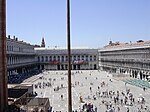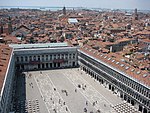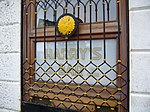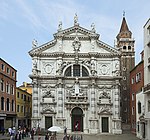San Geminiano, Venice

San Geminiano was a Roman Catholic church located in Piazza San Marco in Venice, Italy, dedicated to Saint Geminianus. It is believed to have been founded by the Byzantines in the 6th century AD and it was destroyed and rebuilt several times over subsequent centuries. The last reconstruction began in 1505 to designs of the architect Cristoforo da Legname, and it was completed by Jacopo Sansovino in 1557. This church was a significant example of Venetian Renaissance architecture, and it was well-known for being ornate and richly decorated. The building was demolished in 1807 in order to make way for the Napoleonic wing of the Procuratie, and many of the artworks it contained were distributed among other churches and museums.
Excerpt from the Wikipedia article San Geminiano, Venice (License: CC BY-SA 3.0, Authors, Images).San Geminiano, Venice
St. Mark's Square, Venice Venezia-Murano-Burano
Geographical coordinates (GPS) Address Nearby Places Show on map
Geographical coordinates (GPS)
| Latitude | Longitude |
|---|---|
| N 45.433638888889 ° | E 12.337138888889 ° |
Address
Procuratie Nuovissime
St. Mark's Square
30170 Venice, Venezia-Murano-Burano
Veneto, Italy
Open on Google Maps










